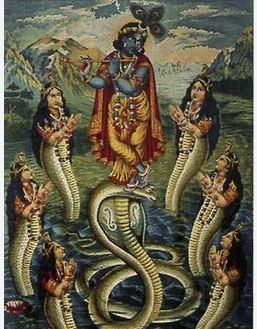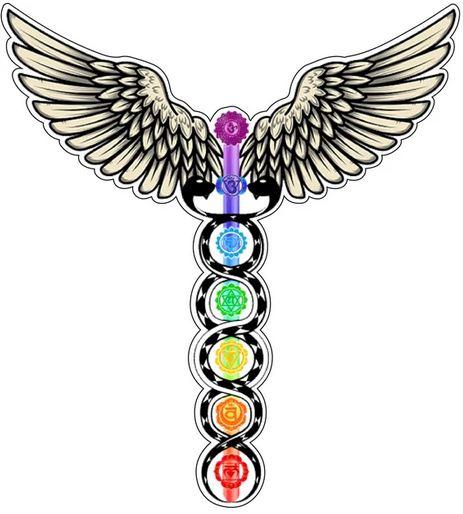
The symbol of the snake has profound and diverse meaning in many esoteric and spiritual traditions. It is often portrayed as a symbolic being that contains both positive and negative aspects. The snake is a multifaceted symbol that is interpreted differently in different cultures and religious contexts. Generally, it is associated with change, renewal, wisdom, and also with danger and seduction.
Snake as a Symbol of Transformation and Renewal
A central characteristic of the snake is its ability to shed its skin, which is understood as a symbol of renewal, change, and transformation. The snake sheds its old skin and enters a new life. This has a strong connection to the idea of spiritual renewal and the transformation from a lower to a higher state. In many esoteric traditions, the process of shedding is associated with overcoming inner blockages and liberation from old patterns.
In this context, the snake can be understood as a symbol of the path to spiritual enlightenment and inner growth. It represents the process of self-realization, which is often associated with a new consciousness and an expanded understanding of one's own nature and the world.
The Snake as a Symbol of Wisdom
In many ancient cultures, the snake was venerated as a symbol of wisdom. A prominent example of this is the snake in the Garden of Eden in the Christian tradition, which acts as a tempter and entices Eve to eat from the Tree of Knowledge. In this story, the snake is associated with knowledge, insight, and forbidden secrets that lead to enlightenment, but also to prohibitions and consequences. In this sense, the snake can be understood as a symbol of deeper, hidden knowledge or the transcending of boundaries to reach a higher truth.
In other traditions, such as Greek mythology, the snake is venerated as a symbol of healing and wisdom. The Rod of Asclepius, used in medicine, depicts a snake coiled around a staff—a symbol of healing and medical wisdom.
Snake in Kabbalah and Mysticism
In Kabbalah and other mystical traditions, the snake is considered a symbol of Kundalini energy, a spiritual force that rests at the base of the spine (the root chakra). The Kundalini snake is described as a potential, hidden knowledge or spiritual force that rises through the chakra system when awakened. The awakening of Kundalini energy leads to higher spiritual enlightenment and transformation of consciousness.
In this mysticism, the snake can be understood as a symbol of the inner forces that enable the path to spiritual elevation. It represents the self's journey to perfection and enlightenment.
Snake as a Symbol of Danger and Seduction
The snake also has a darker meaning in many cultures and is often associated with seduction, danger, and sin. This is particularly evident in the biblical story of Adam and Eve in the Garden of Eden, in which the snake appears as the temptress who entices Eve to acquire forbidden knowledge. Here, the snake represents the fall of humanity and the transition from the innocent to the known.
In Gnosis and other esoteric teachings, the snake can also be understood as a symbol of the pitfalls of the material world and the disintegration of primordial innocence and harmony. It represents the danger of knowledge or of transcending boundaries, which can bring liberation, seduction, or destruction.
The Snake in Hinduism
In Hinduism, the snake is an ambivalent symbol that can represent both divine and demonic aspects. The snake is often associated with Kundalini, the energy that rises up the spine and promotes spiritual awakening.
Another well-known symbol is the serpent Ananta (or Shesha), which supports the earth and is often depicted in depictions of Vishnu as a divine serpent. In this case, the snake represents stability, eternity, and divine support.
Snake in Alchemy
In alchemy, the snake plays a central role as a symbol of the cycle of eternity and the union of opposites. Alchemists saw the serpent as the symbol of the divine cycle of birth and death, as well as transformation. A common alchemical symbol is the Uroboros, a serpent devouring its own tail, symbolizing the cycle of end and beginning, as well as perfection and eternity.
The Uroboros serpent represents the infinite cycle of destruction and creation, reflecting the constant renewal of the world and life.
In alchemy, it also symbolizes the process of inner purification and transformation that leads to higher spiritual insight.
Snake Symbols in Western Esotericism
In Western esotericism and Freemasonry, the snake also has symbolic significance. It is frequently used as a symbol of healing, insight, and transformation. Its dual nature, both positive and negative, reflects the dualism and complexity of human life and the spiritual journey.
Another well-known esoteric connection is the symbol of the Aesculapian serpent (the snake coiled around a staff), which symbolizes the healing arts and the understanding of the body and soul.
Summary
The snake is an extremely ambiguous and meaningful symbol in esotericism and spirituality. It represents transformation, renewal, and wisdom, as well as danger, seduction, and the crossing of boundaries. Depending on the context, it can be interpreted as a symbol of spiritual growth, Kundalini energy, the resolution of inner conflicts, or as a symbol of the Uroboros (infinite cycle). In many spiritual and mystical systems, it is a symbol of the path to enlightenment and the discovery of deeper truths about oneself and the universe.









